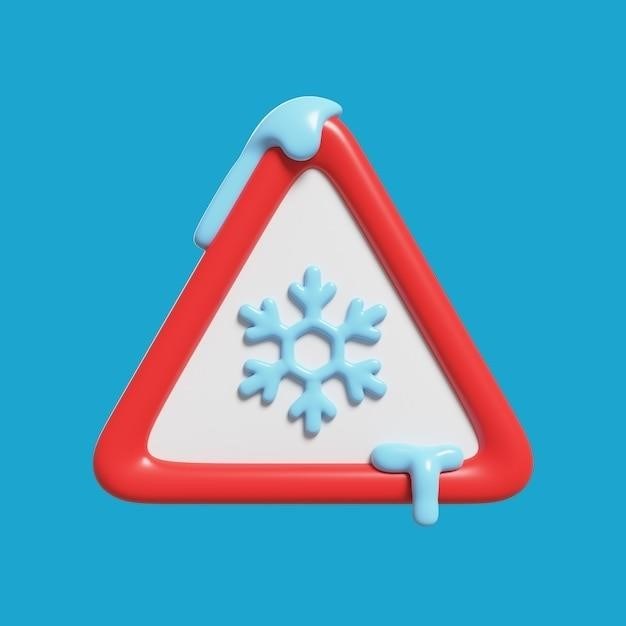ColdCalm Instructions⁚ A Comprehensive Guide
ColdCalm is a homeopathic medicine designed to provide temporary relief from common cold symptoms such as sneezing, runny nose, and nasal congestion. It is formulated with a blend of natural ingredients that work synergistically to address the root cause of cold discomfort.
Introduction
ColdCalm is a homeopathic remedy specifically designed to provide temporary relief from the common cold’s unpleasant symptoms. It stands out as a natural and gentle approach to managing cold discomforts, making it suitable for individuals of all ages, including infants and children. This comprehensive guide will delve into the intricacies of ColdCalm, exploring its dosage, administration, frequency of use, and potential side effects, along with its effectiveness and safety. We’ll also examine the scientific basis behind its homeopathic approach, delving into the key ingredients and clinical studies supporting its use.
Whether you’re seeking a natural alternative to conventional cold medications or simply want to learn more about ColdCalm’s effectiveness, this guide aims to provide you with a comprehensive understanding of this popular homeopathic remedy.
Dosage and Administration
ColdCalm comes in various forms, including tablets and liquid drops, each with specific dosage instructions. For adults and children 6 years of age or older, the recommended dosage at the onset of cold symptoms is to dissolve 2 tablets in the mouth every 15 minutes for the first hour. Following this initial hour, the dosage is reduced to 2 tablets every 30 minutes. For children between 3 and 6 years old, the recommended dosage is 1 tablet every 15 minutes for the first hour, followed by 1 tablet every 30 minutes.
If using the liquid drops, the dosage varies based on age. For children 6 months to 2 years old, the recommended dosage is 5 drops every 15 minutes for the first hour, followed by 5 drops every 30 minutes. For children 2 to 6 years old, the dosage increases to 10 drops every 15 minutes for the first hour, followed by 10 drops every 30 minutes. For adults and children 6 years and older, the dosage is 15 drops every 15 minutes for the first hour, followed by 15 drops every 30 minutes. It is crucial to follow the specific dosage instructions provided on the product packaging or as advised by a healthcare professional.
Frequency of Use
The frequency of ColdCalm use depends on the severity of cold symptoms and individual response. For adults and children 6 years of age or older, the initial dosage regimen involves dissolving 2 tablets in the mouth every 15 minutes for the first hour, followed by 2 tablets every 30 minutes. This frequent administration aims to provide rapid relief from the onset of cold symptoms. After the initial hour, the frequency can be adjusted based on symptom improvement.
For children between 3 and 6 years old, the initial dosage is 1 tablet every 15 minutes for the first hour, followed by 1 tablet every 30 minutes. For infants and toddlers under 3 years old, the recommended dosage is 1 dose (tablet or liquid drops) at the onset of symptoms, repeated up to 6 times a day. The frequency can be adjusted based on the child’s individual response and the severity of cold symptoms. It’s crucial to monitor the child’s condition and consult a healthcare professional if symptoms worsen or persist.
It’s important to note that the frequency of ColdCalm use may vary depending on the individual’s needs and response. It’s always advisable to consult a healthcare professional for personalized guidance and dosage recommendations.
Target Audience
ColdCalm is designed to address the common cold symptoms in a wide range of individuals, making it a versatile option for families and individuals seeking natural relief. The product caters to adults and children as young as 6 months old, offering a safe and effective solution for various age groups. For adults and children 6 years of age and older, ColdCalm is available in tablet form, providing a convenient and easy-to-administer option. For infants and toddlers under 3 years old, ColdCalm is available in liquid drops, ensuring a gentle and palatable administration for the youngest members of the family.
The versatility of ColdCalm extends to its suitability for individuals with varying levels of cold symptom severity. Whether it’s the initial onset of cold symptoms or the persistent discomfort that lingers, ColdCalm aims to provide temporary relief and support the body’s natural healing processes.
While ColdCalm is generally safe for most individuals, it’s crucial to consult a healthcare professional before using it, especially for infants, toddlers, pregnant women, nursing mothers, and individuals with pre-existing medical conditions. This ensures that ColdCalm is appropriate for individual needs and potential interactions with other medications are considered.

Contraindications and Precautions
While ColdCalm is generally considered safe for most individuals, there are certain circumstances where its use should be approached with caution or avoided altogether. Individuals with known allergies to any of the ingredients in ColdCalm should refrain from using the product, as it may trigger allergic reactions such as skin rashes, hives, or difficulty breathing. It is essential to carefully review the product label and ingredient list to identify any potential allergens.
For infants and toddlers under 3 years old, it’s crucial to consult a healthcare professional before administering ColdCalm. This ensures that the product is appropriate for their age and any potential risks or interactions are considered. Additionally, pregnant women and nursing mothers should also consult with their healthcare provider before using ColdCalm, as the safety of homeopathic remedies during pregnancy and breastfeeding has not been fully established.
Individuals with pre-existing medical conditions, such as diabetes, high blood pressure, or autoimmune disorders, should consult with their doctor before using ColdCalm. This is to ensure that the product does not interact with any medications they are currently taking or exacerbate their existing conditions. It’s always advisable to err on the side of caution and seek professional guidance before using any new medications or supplements, especially if you have any underlying health concerns.
Side Effects
ColdCalm is generally well-tolerated and has a low risk of side effects when used as directed. However, as with any medication or supplement, there is a possibility of experiencing adverse reactions. The most common side effect reported with ColdCalm is mild gastrointestinal upset, such as nausea or stomach cramps. This is typically temporary and resolves on its own.
Some individuals may experience allergic reactions to the ingredients in ColdCalm, particularly those with known allergies to homeopathic remedies or specific herbs. Symptoms of an allergic reaction can include skin rashes, hives, itching, swelling, difficulty breathing, or even anaphylaxis. If you experience any of these symptoms after taking ColdCalm, discontinue use immediately and seek medical attention.
It’s important to note that the information provided here is not a substitute for professional medical advice. If you have any concerns about the potential side effects of ColdCalm, consult with your healthcare provider. They can provide personalized guidance based on your individual health history and medical conditions.
Storage and Handling
Proper storage and handling of ColdCalm are essential to maintain its potency and effectiveness. To ensure optimal results, follow these guidelines⁚
- Store ColdCalm tablets in a cool, dry place, away from direct sunlight and heat. Avoid exposing them to extreme temperatures or humidity.
- Keep ColdCalm tablets out of reach of children and pets to prevent accidental ingestion. Always supervise children when administering any medication.
- Do not use ColdCalm tablets after the expiration date printed on the packaging. Expired medications may lose their effectiveness and could potentially be harmful.
- If you notice any changes in the appearance or smell of ColdCalm tablets, such as discoloration or an unusual odor, discard them and do not use them. This could indicate that the medication has been compromised.
- Always consult with a healthcare professional before using ColdCalm, especially if you are pregnant, breastfeeding, or have any underlying medical conditions. They can advise on the appropriate dosage and whether ColdCalm is suitable for you.
By following these storage and handling instructions, you can help ensure that your ColdCalm tablets remain effective and safe for use.
Key Ingredients
ColdCalm’s effectiveness stems from its unique blend of homeopathic ingredients, meticulously chosen for their ability to address the symptoms of the common cold. These ingredients work synergistically to provide relief from a variety of cold-related discomforts.
- Allium cepa (Onion)⁚ This ingredient is known for its ability to relieve watery nasal discharge and sneezing, common symptoms of the common cold.
- Arsenicum album (White Arsenic)⁚ This homeopathic remedy is often used for symptoms like chills, fever, and a burning sensation in the nose, which can be associated with the common cold.
- Eupatorium perfoliatum (Boneset)⁚ This ingredient is known for its ability to alleviate aches and pains, including those associated with a cold.
- Gelsemium sempervirens (Yellow Jessamine)⁚ This ingredient is often used to relieve muscle aches and pains, as well as headaches and chills, common symptoms of the common cold.
- Bryonia alba (White Bryony)⁚ This ingredient is known for its ability to relieve dry, hacking coughs and muscle soreness, which can be associated with a cold.
These carefully selected ingredients, in their homeopathic form, work together to address the various symptoms of the common cold, providing natural relief and supporting the body’s natural healing process.
Homeopathic Approach
ColdCalm embraces the principles of homeopathy, a system of medicine that views disease as a disturbance in the body’s vital force. Homeopathy utilizes highly diluted substances, known as remedies, that are believed to stimulate the body’s natural healing capabilities. The principle behind homeopathy is “like cures like,” meaning that a substance that causes certain symptoms in a healthy individual can be used in a highly diluted form to treat those same symptoms in a sick individual.
ColdCalm’s homeopathic approach focuses on addressing the underlying cause of cold symptoms rather than simply suppressing them. The selected ingredients, when diluted and prepared according to homeopathic principles, are believed to stimulate the body’s natural defenses and promote a gentle return to health. This approach aims to help the body regain its natural balance and restore its ability to combat the cold effectively.
Homeopathy emphasizes individualized treatment, considering not only the specific symptoms but also the overall health and constitution of the individual. This personalized approach allows for a more targeted and effective treatment plan, addressing the unique needs of each patient.
Clinical Studies and Evidence
The effectiveness of homeopathic remedies, including ColdCalm, has been a subject of ongoing debate and research. While some studies have shown promising results, others have failed to demonstrate significant efficacy. The scientific evidence supporting the effectiveness of homeopathy in general, and ColdCalm specifically, remains limited and inconclusive.
One of the challenges in evaluating homeopathic remedies is the inherent complexity of the human body and the difficulty in isolating the effects of specific ingredients. Additionally, the highly diluted nature of homeopathic preparations makes it challenging to conduct rigorous scientific studies that can definitively prove their efficacy.
Proponents of homeopathy argue that the lack of robust clinical evidence is due to the inherent limitations of traditional scientific methods in evaluating complex biological systems. They believe that homeopathic remedies work by stimulating the body’s natural healing mechanisms, which may not be readily quantifiable through conventional research methods.
Despite the ongoing debate, it is important to note that ColdCalm is a generally safe and well-tolerated homeopathic remedy. However, it is crucial to consult with a healthcare professional to discuss any concerns and determine if ColdCalm is appropriate for your individual needs.
Consumer Reviews and Testimonials
Consumer reviews and testimonials offer valuable insights into the perceived effectiveness and user experience of ColdCalm. Many users report positive experiences with ColdCalm, highlighting its ability to provide relief from cold symptoms, particularly in the early stages of a cold. Some consumers praise its effectiveness in reducing sneezing, runny nose, and congestion, while others appreciate its gentle and natural approach to cold relief.
However, it is important to note that individual experiences with ColdCalm can vary widely. Some users may experience minimal or no relief from their symptoms, while others may find it to be highly effective. The effectiveness of ColdCalm may also depend on the severity and duration of the cold, as well as individual factors such as age, health status, and sensitivity to homeopathic remedies.
It is crucial to remember that consumer reviews and testimonials should be considered anecdotal evidence and should not be taken as a substitute for professional medical advice. If you are experiencing persistent or severe cold symptoms, it is always best to consult with a healthcare professional for proper diagnosis and treatment.
Comparison with Other Cold Remedies

ColdCalm, as a homeopathic remedy, stands out from traditional over-the-counter cold medications. While conventional cold medicines often contain decongestants, antihistamines, and pain relievers, ColdCalm relies on a blend of natural ingredients to address cold symptoms holistically. This approach may appeal to individuals seeking a gentler and more natural alternative to traditional remedies, particularly those concerned about potential side effects associated with conventional medications.
However, it is important to recognize that the effectiveness of ColdCalm compared to conventional cold remedies is a subject of ongoing debate and research. While some studies have shown promising results for homeopathic remedies in managing cold symptoms, further research is needed to establish definitive conclusions. Moreover, the efficacy of homeopathic remedies can vary depending on individual factors and the severity of symptoms.
Ultimately, the choice between ColdCalm and other cold remedies depends on individual preferences, health conditions, and the severity of symptoms. Consulting with a healthcare professional can provide personalized guidance and recommendations based on individual needs and circumstances.
ColdCalm offers a natural and potentially gentler approach to managing common cold symptoms, particularly for individuals seeking alternatives to traditional medications. Its homeopathic formulation aims to stimulate the body’s natural healing processes, promoting a holistic approach to wellness. While the effectiveness of ColdCalm compared to conventional cold remedies is still under investigation, its potential benefits, particularly in terms of reduced side effects, make it a viable option for some individuals.
However, it’s crucial to remember that ColdCalm is not a substitute for professional medical advice; If you experience severe or persistent cold symptoms, it’s essential to consult a healthcare professional for proper diagnosis and treatment. Always follow the recommended dosage and instructions provided on the product label and seek guidance from your doctor or pharmacist if you have any questions or concerns.
Ultimately, choosing the right cold remedy depends on individual needs, preferences, and the severity of symptoms. By considering the pros and cons of various options, including ColdCalm, individuals can make informed decisions to support their health and well-being during the cold season.
